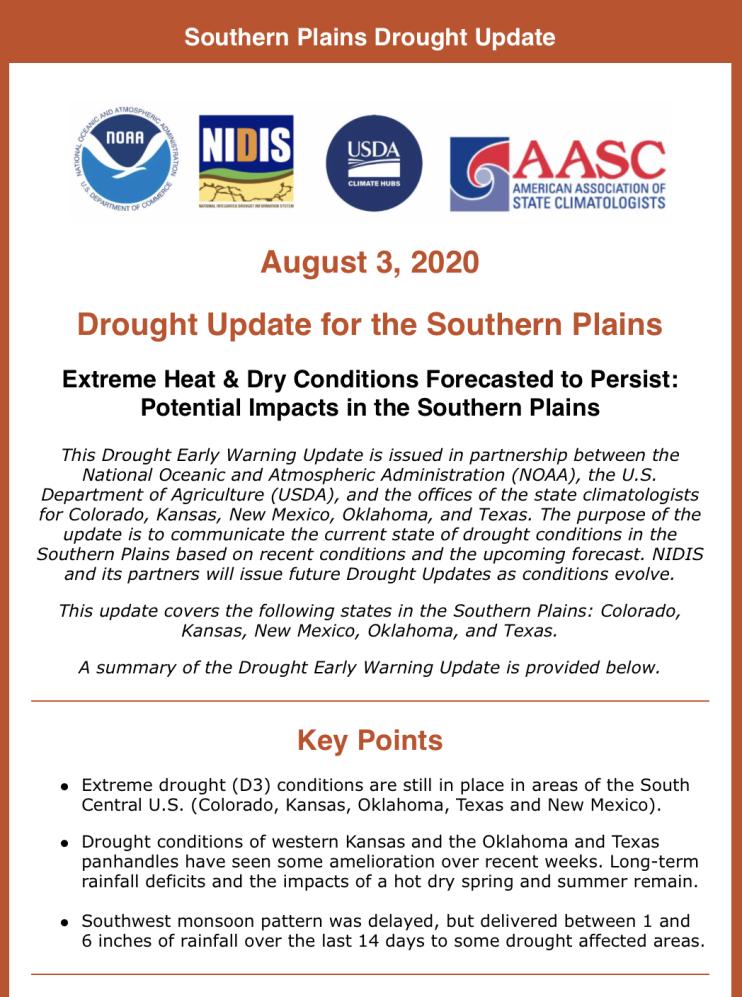Drought Update for the Southern Plains: August 3, 2020
This drought status update was originally sent via email to the Southern Plains DEWS email list.
Extreme Heat & Dry Conditions Forecasted to Persist: Potential Impacts in the Southern Plains
This Drought Early Warning Update is issued in partnership between the National Oceanic and Atmospheric Administration (NOAA), the U.S. Department of Agriculture (USDA), and the offices of the state climatologists for Colorado, Kansas, New Mexico, Oklahoma, and Texas. The purpose of the update is to communicate the current state of drought conditions in the Southern Plains based on recent conditions and the upcoming forecast. NIDIS and its partners will issue future Drought Updates as conditions evolve.
This update covers the following states in the Southern Plains: Colorado, Kansas, New Mexico, Oklahoma, and Texas.
A summary of the Drought Early Warning Update is provided below.
Key Points
- Extreme drought (D3) conditions are still in place in areas of the South Central U.S. (Colorado, Kansas, Oklahoma, Texas and New Mexico).
- Drought conditions of western Kansas and the Oklahoma and Texas panhandles have seen some amelioration over recent weeks. Long-term rainfall deficits and the impacts of a hot dry spring and summer remain.
- Southwest monsoon pattern was delayed, but delivered between 1 and 6 inches of rainfall over the last 14 days to some drought affected areas.
Current Conditions
U.S. Drought Monitor Conditions
- Severe (D2) to extreme (D3) drought persists across much of Colorado (59% of the State), Kansas (4%), Oklahoma (10%), northern Texas (15%) and New Mexico (46%).
- The 30 July, 2020, US Drought Monitor does not show any patches of exceptional drought (D4).
- Severe (D2) drought conditions have been in place in this region since October 2019.
- In general, this entire 5 state area has seen overall improvement in the past 30 days.
- Most of the northern tier of TX Panhandle counties have seen 150% plus of normal rainfall in this period, as well as most of Texas County in the OK Panhandle and the counties in southwest KS, southeast CO, and Union County in northeast NM.
- A few areas that have missed out on recent rainfall and remain in extreme (D3) drought includes northern Cimarron County in OK and southwest Baca County in CO, as well as parts of Union County in NM.
Outlooks
Temperature Outlook
There is a greater chance for above-normal temperatures across the southwestern part of the Southern Plains and below-normal temperatures across the northeastern part.
Precipitation Outlook
The rainfall outlook shows an equal chance of above or below normal rainfall for August across most of the Southern Plains region. There is still a chance for the seasonal monsoon to provide rainfall through August, but forecasts suggest below normal rainfall is most likely for western New Mexico and Colorado.
Drought Outlook
The August Monthly Droughty Outlook forecasts that drought will persist in the Southern Plains, with some expansion in parts of KS and TX.
State-Based Conditions and Impacts
Kansas
- Widespread precipitation has occurred in western KS with general improvement, although moderate to severe drought continues.
- Continued deterioration in southeast KS, as the rains missed most of the area.
- Rains in the center third of the state increased drought-free areas and saturated soils have resulted in localized flooding.
Oklahoma
- Significant rains over the last 60 days have virtually eliminated drought across north central into central Oklahoma.
- Moderate-to-extreme drought continues across the western half of the state.
- Drought continues to intensify and spread across southwestern Oklahoma.
- Southeastern Oklahoma is also seeing more abnormally dry conditions creep into the area over the last 30 days.
Texas
- Rainfall over the past few weeks has provided ample moisture for the extreme northern counties of the Texas Panhandle but has left most other locations high and dry. Drought conditions vary dramatically across the region with respect to both severity and impacts.
- July so far ranks among the five hottest Julys on record for most of the region, enhancing evaporation rates and making drought impacts worse.
- The next few weeks are likely to provide a continuation of the summertime pattern of above normal temperatures and occasional thunderstorms, with the uneven distribution of thunderstorms continuing to produce winners and losers.
- Percent of normal precipitation for northern Texas, past month (left), past 3-months (center), past year (right)
Colorado
- Persistent monsoonal flow brought much needed moisture to southern Colorado over the past week, but still not enough to eliminate the longer-term deficits.
- Relief is only temporary as a ridge of high pressure will block monsoonal flow, bringing high temperatures and dry conditions over the next couple of weeks.
- High evaporative demand and vegetative stress have migrated into northern portions of the state.
- Drought conditions worsen over northern and northwest Colorado as locally heavier amounts of rain stay to the south, and the lighter accumulations in the north and west slopes can’t keep up with average.
New Mexico
- 94% of the state is in moderate (D1) drought or above.
- A potential La Niña pattern in the Pacific would mean a dry winter is likely.
For More Information
- NIDIS and its partners will issue future Drought Early Warning Updates as conditions evolve.
- More local information is available from the following resources:
Prepared By
Joel Lisonbee
NOAA/National Integrated Drought Information System (NIDIS)
John Nielsen-Gammon
Regents Professor and Texas State Climatologist
Department of Atmospheric Sciences, Texas A&M University
Victor Murphy
Climate Services Program Manager, National Weather Service Southern Region
Mary Knapp
Weather Data Library and Kansas Assistant State Climatologist
Dept. of Agronomy, Kansas State University
Gary McManus
Oklahoma State Climatologist
Oklahoma Mesonet, and Oklahoma Climatological Survey
Becky Bolinger
Colorado Climate Center, Assistant State Climatologist
Colorado State University Dept. Atmospheric Science
Dave DuBois
New Mexico State Climatologist, Director of the NM Climate Center
Associate Professor, New Mexico State University





